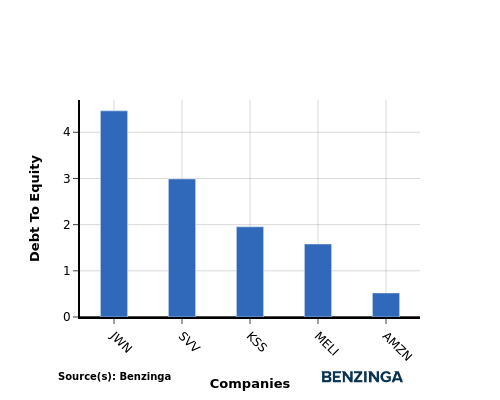Amidst the fast-paced and highly competitive business environment of today, conducting comprehensive company analysis is essential for investors and industry enthusiasts. In this article, we will delve into an extensive industry comparison, evaluating Amazon.com AMZN in comparison to its major competitors within the Broadline Retail industry. By analyzing critical financial metrics, market position, and growth potential, our objective is to provide valuable insights for investors and offer a deeper understanding of company's performance in the industry.
Amazon.com Background
Amazon is the leading online retailer and marketplace for third party sellers. Retail related revenue represents approximately 75% of total, followed by Amazon Web Services' cloud computing, storage, database, and other offerings (15%), advertising services (5% to 10%), and other the remainder. International segments constitute 25% to 30% of Amazon's non-AWS sales, led by Germany, the United Kingdom, and Japan.
| Company | P/E | P/B | P/S | ROE | EBITDA (in billions) | Gross Profit (in billions) | Revenue Growth |
|---|---|---|---|---|---|---|---|
| Amazon.com Inc | 45.75 | 8.69 | 3.69 | 6.19% | $32.08 | $31.0 | 11.04% |
| Alibaba Group Holding Ltd | 23.84 | 1.70 | 1.76 | 2.52% | $36.56 | $97.13 | 3.88% |
| PDD Holdings Inc | 12.21 | 4.49 | 3.53 | 13.54% | $37.97 | $63.36 | 85.65% |
| MercadoLibre Inc | 68.50 | 24.46 | 5.35 | 10.37% | $0.72 | $2.44 | 35.27% |
| JD.com Inc | 13.03 | 1.71 | 0.37 | 5.71% | $16.3 | $45.94 | 1.2% |
| Coupang Inc | 45.53 | 11.12 | 1.61 | 1.74% | $0.28 | $2.27 | 27.2% |
| eBay Inc | 15.59 | 5.47 | 3.08 | 11.59% | $0.95 | $1.85 | 3.04% |
| Vipshop Holdings Ltd | 6.64 | 1.41 | 0.50 | 5.1% | $2.32 | $6.34 | -3.6% |
| Dillard's Inc | 9.59 | 3.23 | 0.94 | 3.9% | $0.15 | $0.58 | -5.18% |
| Ollie's Bargain Outlet Holdings Inc | 28.10 | 3.55 | 2.57 | 3.14% | $0.08 | $0.22 | 12.41% |
| MINISO Group Holding Ltd | 18.04 | 4.19 | 2.94 | 6.26% | $0.79 | $1.77 | 24.08% |
| Macy's Inc | 23.18 | 0.97 | 0.18 | 3.53% | $0.44 | $2.16 | -3.48% |
| Nordstrom Inc | 13.33 | 3.99 | 0.26 | 13.68% | $0.4 | $1.49 | 3.23% |
| Kohl's Corp | 7.09 | 0.53 | 0.12 | 1.73% | $0.35 | $1.6 | -4.18% |
| Savers Value Village Inc | 21.26 | 3.61 | 1.07 | 5.09% | $0.07 | $0.22 | 0.53% |
| Average | 21.85 | 5.03 | 1.73 | 6.28% | $6.96 | $16.24 | 12.86% |
When conducting a detailed analysis of Amazon.com, the following trends become clear:
-
The Price to Earnings ratio of 45.75 for this company is 2.09x above the industry average, indicating a premium valuation associated with the stock.
-
The elevated Price to Book ratio of 8.69 relative to the industry average by 1.73x suggests company might be overvalued based on its book value.
-
The Price to Sales ratio of 3.69, which is 2.13x the industry average, suggests the stock could potentially be overvalued in relation to its sales performance compared to its peers.
-
With a Return on Equity (ROE) of 6.19% that is 0.09% below the industry average, it appears that the company exhibits potential inefficiency in utilizing equity to generate profits.
-
The Earnings Before Interest, Taxes, Depreciation, and Amortization (EBITDA) of $32.08 Billion is 4.61x above the industry average, highlighting stronger profitability and robust cash flow generation.
-
The company has higher gross profit of $31.0 Billion, which indicates 1.91x above the industry average, indicating stronger profitability and higher earnings from its core operations.
-
The company's revenue growth of 11.04% is significantly below the industry average of 12.86%. This suggests a potential struggle in generating increased sales volume.
Debt To Equity Ratio

The debt-to-equity (D/E) ratio provides insights into the proportion of debt a company has in relation to its equity and asset value.
Considering the debt-to-equity ratio in industry comparisons allows for a concise evaluation of a company's financial health and risk profile, aiding in informed decision-making.
By evaluating Amazon.com against its top 4 peers in terms of the Debt-to-Equity ratio, the following observations arise:
-
Compared to its top 4 peers, Amazon.com has a stronger financial position indicated by its lower debt-to-equity ratio of 0.52.
-
This suggests that the company relies less on debt financing and has a more favorable balance between debt and equity, which can be seen as a positive attribute by investors.
Key Takeaways
For Amazon.com, the PE, PB, and PS ratios are all high compared to its peers in the Broadline Retail industry, indicating that the stock may be overvalued. The low ROE suggests that Amazon.com is not generating significant returns on shareholder equity. However, the high EBITDA and gross profit margins show strong operational performance. The low revenue growth rate may be a concern for future earnings potential compared to industry peers.
This article was generated by Benzinga's automated content engine and reviewed by an editor.
© 2024 Benzinga.com. Benzinga does not provide investment advice. All rights reserved.







